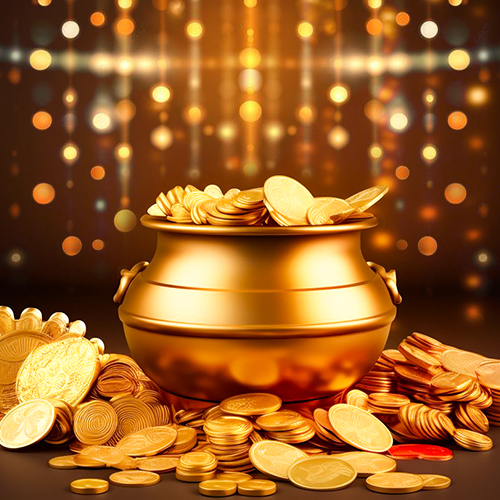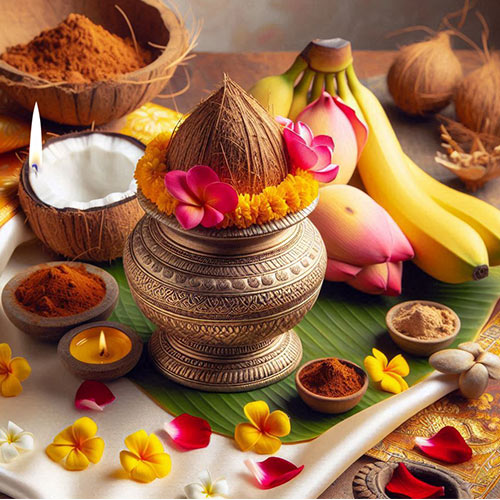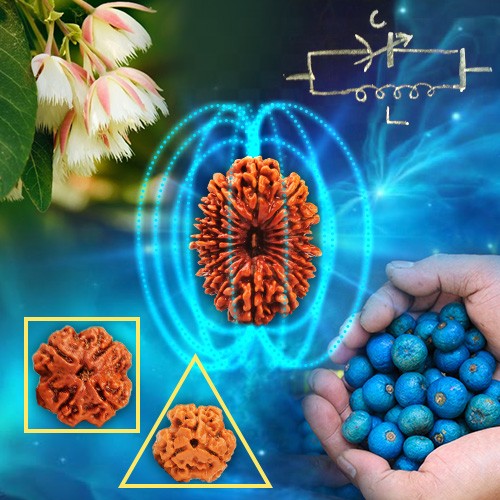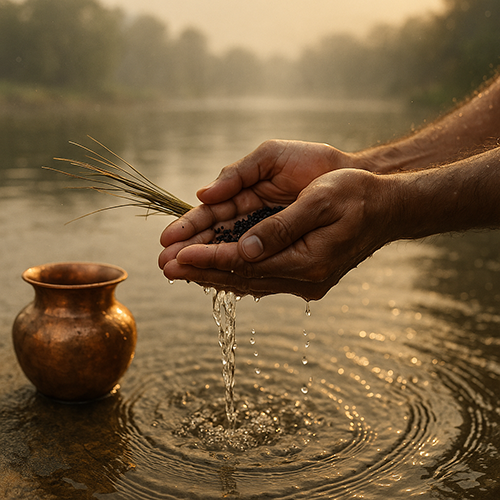In the sacred rhythm of daily worship and festive rituals, silver holds a revered place, worshipped as Divine Silver idols, offered as Sacred Silver utensils, or worn as Spiritual Silver Jewelry. Yet, Silver is prone to losing its luster over time due to natural tarnishing. In Hindu tradition, cleanliness is not merely about physical appearance, it is a spiritual act that honors the Divine.
Proper Cleaning & Maintenance of these items is not only about appearance; it upholds the sanctity (suddhi) and vibrational integrity (spandana) of your spiritual tools.
Why Silver Tarnishes Over Time?
Silver, while revered for its beauty and timeless appeal, is highly susceptible to tarnishing over time. Tarnish is a layer of corrosion that forms when silver reacts with Oxygen present in the air. This discoloration can detract from silver's luster, but understanding the causes of tarnishing can help mitigate its effects.
Here are the primary factors responsible for tarnishing:
Exposure to Air and Moisture:
Silver is prone to tarnish when exposed to air, especially in humid environments. Oxygen in the air reacts with the metal, leading to oxidation. Combined with moisture, the tarnishing process accelerates, resulting in a dull, grayish appearance which eventually turns black
Chemicals:
Everyday chemicals, such as perfumes, lotions, hairsprays, and chlorine, can all contribute to tarnishing. These chemicals often contain sulfur compounds, which react with silver and create a layer of tarnish. Even chlorine from swimming pools or cleaning agents can cause damage, particularly if silver jewelry is worn while swimming or bathing.
Storing with Non-Anti-Tarnish Materials:
The materials you store silver with can play a significant role in its maintenance. If silver items are kept alongside fabrics, plastic, or certain metals that do not have anti-tarnish properties, the tarnishing process can speed up. It is important to store silver in protective bags or boxes, ideally those lined with anti-tarnish cloth, to keep the tarnish at bay.
Foods like Eggs, Onions, and More (for Silverware):
If you're using silverware, food items rich in sulfur compounds can cause tarnish. Foods like eggs, onions, and mustard contain sulfur, which reacts with silver and results in tarnishing. Regular use and proper care of silverware can help avoid this issue, but it's always best to clean silver utensils properly after each use.
How Often Should You Clean Silver?
Cleaning silver is essential to maintain its shine and appearance, but the frequency of cleaning depends on the item’s usage and exposure to tarnish-causing elements. There are two main aspects of silver care: polishing and deep cleaning.
Frequency Based on Usage and Exposure:
- Regular Wear: If you wear silver jewelry or use silverware often, you may notice dullness developing over time. For pieces that are frequently worn, like rings or necklaces, cleaning every few weeks or once a month is usually sufficient to keep tarnish at bay.
- Occasional Use: For silver pieces that are worn less frequently, such as special occasion jewelry or silver decorations, cleaning them once every 3-4 months may be enough.
- High Tarnish Exposure: If your silver is exposed to chemicals (such as when swimming in chlorinated water) or harsh environmental conditions, cleaning more regularly is recommended to prevent tarnish buildup.
Difference Between Polishing and Deep Cleaning:
- Polishing: Polishing silver removes light tarnish and enhances its natural shine. This is typically done with a soft cloth and a silver polish or cleaner. Polishing is best done when the tarnish is minimal, and it can be done more frequently without damaging the silver.
- Deep Cleaning: Deep cleaning involves using stronger methods to remove more substantial tarnish. This could include using silver dips, foaming cleaners, or a paste made of baking soda and water. Deep cleaning should be done less frequently, only when tarnish has built up and normal polishing isn’t enough to restore the silver’s appearance.
By following these tips and understanding what causes silver to tarnish, you can extend the life and beauty of your silver items. Regular cleaning, coupled with proper storage and careful use, will ensure that your silver remains shiny and beautiful for years to come.
How to Clean Silver Idols, Jewelry & Puja Vessels
Here are some home remedies to remove Tarnish from your Spiritual Silver Products:
Lemon and Salt Scrub (Traditional Indian Method)
A time-honored method safe for all types of Silver Items
Steps:
- Cut a lemon in half and sprinkle salt over it
- Rub directly over the tarnished silver idol
- Let it sit for 1–2 minutes
- Rinse with clean water and wipe dry
Avoid on:
- Oxidized or Antique-Finish Silver
- Intricate or Detailed Carvings
- Silver with Gemstones
Baking Soda & Aluminum Foil (Deep Cleaning)
This method is suitable for heavily tarnished silver items but should not be used on antique or oxidized finishes because it will remove the Oxidized Finish of the items as well. Avoid this method for Gemstone Silver Mix Jewelry because the abrasive nature of Baking Soda & the Hot Water can damage the Gemstone.
Steps:
- Line a bowl with aluminum foil
- Place idol inside and sprinkle baking soda
- Pour boiling water over it (enough to submerge)
- Wait for 5–10 minutes
- Rinse and dry thoroughly
Avoid on:
- Oxidized or Antique Silver
- Silver with Gemstones (abrasive + heat risk)
- Silver-Plated Items
Baking Soda & Vinegar (Chemical Reaction Method)
This method uses a natural chemical reaction to lift tarnish from silver surfaces.
Steps:
- Place the Silver Items in a bowl
- Pour enough Vinegar that all the Silver Items are completely submerged
- Add 2 tablespoons for baking soda, it will fizz as it reacts with vinegar
- Let it sit for 2 to 5 minutes
- Gently scrub using a soft toothbrush or cloth to rub off the remaining tarnish
- Rinse the Silver Items thoroughly to make sure all Baking Soda & Vinegar residue is removed
- Use soft cloth to dry the Silver Items
Avoid on:
- Gemstone-Set Jewelry
- Oxidized or Antique-Finish Silver
- Silver-Plated Items
Mild Soap & Lukewarm Water (Safest Method)
This is the safest method to clean Silver Idols with Antique Finish, Oxidized Silver Jewelry & Gemstone Set Silver Jewelry.
Steps:
- Mix a few drops of mild soap in lukewarm water
- Use a Cloth or Soft Toothbrush to scrub the tarnished areas
- Rinse it with Clean Water
- Use cloth to wipe it dry
Ideal for:
- Oxidized Silver Jewelry
- Gemstone-Set Jewelry
- Antique-Finish Silver Idols
- Daily Puja Vessels
Plain White Toothpowder or Toothpaste
A backup option using household items, but must be very mild.
Steps:
- Apply Plain White Toothpowder or Paste on the Silver Items
- Let it sit for 2 to 3 minutes
- Rinse with Clean Water & Wipe it Dry
Avoid:
- Fancy, abrasive, or whitening toothpaste
- Use only on plain silver, not oxidized or gemstone pieces
Herbal Polish Cleaner
An herbal silver polish, such as the one offered by Rudra Centre, is free from harmful chemicals and maintains spiritual sanctity.
How to use:
- Take soft cotton cloth
- Apply a small amount of herbal polish
- Rub gently over the surface
- Wipe with clean & dry cloth
Buy Herbal Polish Cleaner from Rudra Centre
Ultrasonic Cleaning Machine
An ultrasonic cleaner is a professional-grade device that uses high-frequency sound waves (ultrasound) in a liquid solution to generate microscopic bubbles. These bubbles gently remove dirt, grime, and buildup from jewelry and metal surfaces with minimal manual effort. This method is highly effective for cleaning plain silver jewelry such as chains, rings, and bracelets. However, it is not recommended for gemstone-set pieces or oxidized silver items, as the intense vibrations may loosen stones or strip away the darkened antique finish.
Best for pure silver chains, rings, and bracelets, but avoid on gemstone or oxidized silver.
Caution: The vibrations may loosen gemstones and erase oxidized finishes.
| Type of Silver Item | Recommended Cleaning Methods | Methods to Avoid |
|---|---|---|
| Gemstone in Silver Ring/Pendant/Bracelet |
• Mild Soap & Lukewarm Water
• Soft Polishing Cloth |
• Baking Soda (abrasive)
• Vinegar & Lemon (acidic) • Ultrasonic Cleaner (can loosen stones) |
| Oxidized Silver (Antique Finish) |
• Mild Soap & Lukewarm Water
• Silver Polishing Cloth (non-abrasive) |
• Baking Soda, Vinegar, Lemon, Toothpaste (all remove oxidized finish) |
| Normal Silver (Plain Jewelry, Idols, Vessels) |
• Baking Soda & Aluminum Foil (for deep tarnish)
• Mild Soap & Lukewarm Water • Lemon & Salt (simple items only) • Ultrasonic Cleaner (for plain designs) |
• Lemon & Salt on intricate carvings
• Abrasives on detailed or soft designs |
Tips to Prevent Silver Tarnish
To keep your silver items shining and free from tarnish, follow these simple yet effective preventive care tips:
- Store in anti-tarnish bags or velvet-lined boxes
- Put Silica Gel Packets or Activated Charcoal wherever Silver Items are stored
- Avoid touching Silver Items with Oily or Sweaty hands
- Regularly Clean Silver Items with Mild Soap Solution & Wipe it dry completely with Cloth after each use
- Keep away from Rubber Bands, Newspapers, or Plastic Bags which contain Sulfur Compounds
Special Considerations for Puja Use
Silver items used in puja are not just utensils but sacred mediums that hold divine energy. To maintain their purity and spiritual efficacy, follow these essential guidelines:
- Avoid Chemical Cleaners: Never use synthetic or alcohol-based silver polishes on puja items. These leave behind impure residues. Instead, opt for natural methods like Vinegar Baking Soda Paste or Lemon Salt Method
- Maintain Ritual Purity (Tamasic-Free): Puja items must be free from physical dirt, chemical residues, stale offerings, and negative energy. Cleanliness ensures the item remains sattvic and fit for invoking divine presence.
- Clean Before Major Rituals: Always purify silverware before festivals like Navratri, Shivratri, Janmashtami, Diwali, or any major vrat. This enhances the sanctity of the ritual and invites higher spiritual vibrations.
When to Seek Professional Cleaning
Consider professional services if:
- The idol is antique or has oxidized detailing
- Jewelry includes fragile gemstones
- You’re unsure about the plating status of the item
Professional jewelers use ultrasonic cleaning and gentle buffing techniques safe for intricate work.
Conclusion:
Caring for Silver Idols, Jewelry, and Puja Vessels: A Sacred Responsibility
Caring for your silver is not just an act of upkeep, it is a spiritual responsibility. In the wisdom of the Vedic tradition, the state of your altar and ritual items is a reflection of your devotion (bhakti) and reverence (shraddha) toward the Divine. When your sacred items are clean, vibrant, and well preserved, they become powerful vessels of divine energy.
Just as a lamp must be clear to emit its full light, silver idols and puja objects must remain pure to channel grace. When you honor your silver items with gentle and regular care, you invite harmony, positivity, and divine presence into your space. This act of love not only maintains their outer brilliance but deepens your inner connection with the sacred.
Through mindful and respectful care, your silver will continue to inspire, uplift, and elevate your worship for generations to come.


-in-Astrology.jpg)






.jpg)

.png)

Comments 0
Leave your thought here